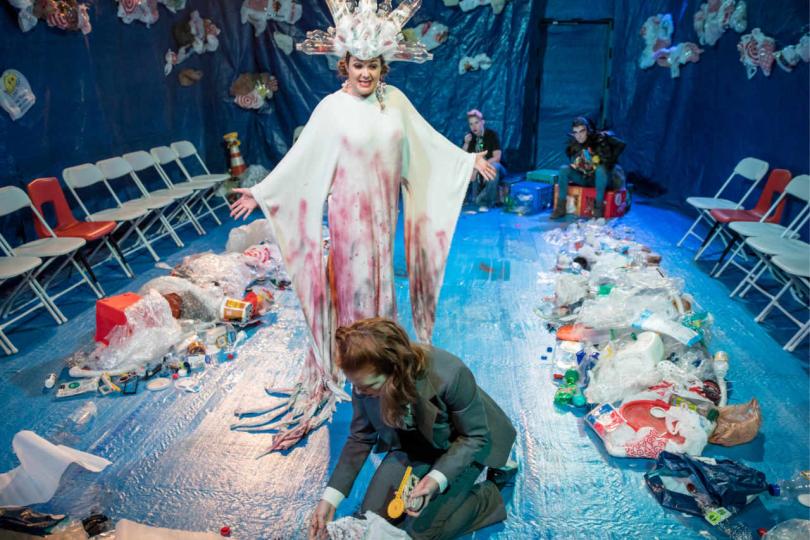Atonement for our collective sins?

Reviewer note: Damon Runnals, co-artistic director and co-founder of Swandive Theatre along with Meg DiSciorio, owns Minnesota Playlist. The opinions below are mine alone.
Ralph Wiley (Nicole Goeden), the inventor of modern plastics, wakes up on a grungy, plastic-choked island. Before him stand three judges who will determine his fate: The Angel of Canopic Jars (Katie Kaufmann), rocker Roger Waters of Pink Floyd fame (Bethany McHugh), and a rotting bird they call The Gooney Revenant (Mairead Koehler). They claim that the tipping point has come and now they are here to punish the wrong doers.
At its heart, The Canopic Jar of My Sins is a morality play, not just because it asks questions like “where is the guilt?” and “who defines evil?”. As Britannica online describes the morality plays of the 15th and 16th century, the plays’ “principal themes were the choice between good and evil, the transitory nature of life, and the immediacy of death, reflecting a medieval preoccupation with the conflict between the spirit and the flesh.” Unlike the rarified import of our modern secular culture and modern Christianity (which try to sever our embodied, physical reality from our consciousness/soul) medieval people had a much more physical understanding of themselves in the world and how that physical world touched the divine. Thus we get saints and the cult of relics from that period—saints being people who actually brought the divine to the muck and represented a tear in the heavenly to touch the profane. Of course, reaffirming this vital connection between our minds and our bodies is precisely what The Canopic Jar of My Sins wants to do: it is a morality play for the modern era, intent on making us culpable for the modern environmental crisis we have caused.
The small, black box space of The Crane is transformed floor to ceiling with Seán McArdle’s set: lurid blue plastic tarps, whimsical-yet-horrifying plastic bag clouds, and drifts of plastic debris. The audience must move carefully around the garbage, taking a (plastic) seat, single file around the thrust stage. It was the fantastic costuming by Lisa Imbryk, however, which from the first moment allowed me into the world of the play. The Angel of Canopic Jars wears an impressive headdress made of plastic bottles with small, chiming glass bottles tied to her hair. Her dress combined with the headdress refer heavily to the Statue of Liberty—this irony is not lost on the audience. To the angel’s right stands Roger Waters, unassuming in plastic shades and a black tee shirt with ripped jeans. To her left, the grotesque Gooney Revenant stands, wings uneven and broken, plastic mixed with its entrails spilling out of its torso. Koehler brings a deeply compelling physicality to her role as The Gooney Revenant. She moves her head just like a bird. The effects of plastic on her body, a theme the play returns to again and again, require a type of physical acting rarely asked for by plays. She delivers a standout performance.
With almost as many black outs as the final Lord of the Rings movie (which are a direction choice), light designer Jesse Cogswell still creates glowing coastal sunsets as well as terrifying night attacks. The Canopic Jar of My Sins never shies away from physicality, with pecking, beatings, and savage kicks all a part of its physical vocabulary. Fight choreographer Annie Enneking has done a fantastic job with the thrust stage. At several points the violence was almost over-the-top, but the performers gave it veritas that keep it from slipping into the gratuitous. This physicality reminds the viewer of the physical consequences of plastics and creates bodily empathy with the players and, ideally, the planet.
Goeden, Kaufmann, Koehler, and McHugh are really well cast in their roles. Goeden brings a crispness and authority to her role as Wiley. The decision to gender-bend Ralph Wiley is inspired, particularly because of the role Wiley’s family plays in his arc during this play. Wiley is a strange mixture of competent inquisitiveness and unreflective middle-management—he is the type of character that makes you wonder about your role in your own day job. Goeden nails his ambivalence, teetering between defiance and breaking down. McHugh (cast as both Roger Waters and Robert Oppenheimer) has the unenviable job to bring nuance to two roles that are very hard to empathize with. Her impeccable comedic timing and a devilish sneer help drive the plot forward when the action on stage feels slow. In some ways Kaufmann has the hardest role of the night – as the Angel she must stay aloof and apart, but so much of the drama comes from her booming pronouncements and acts of vengeance. When she says that Angels meat out punishment, I fully believed her.
This show is “pay what it’s worth,” and I couldn’t help but think that the structure of this echoes the questions posed by the play itself. ‘Pay what it’s worth” is an extension of the themes of this show. What is the world worth? Remember, now that you know, you are culpable.
An excellent version of a fascinating script, I would highly recommend The Canopic Jar of My Sins, which plays until October 19th.




